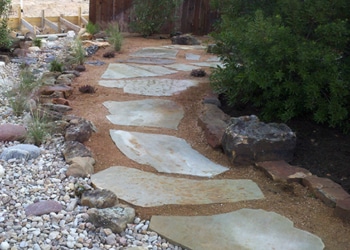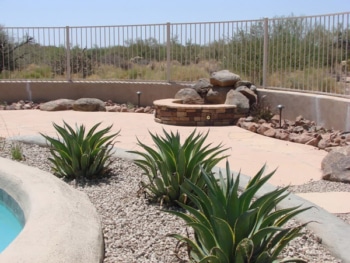Where to begin your project?
The biggest question would be, where do you live? If you live in an arid region where lush lawns are simply not possible, consider desert style landscaping ideas with materials and plant life that work with your natural surroundings.
Some parts of the country get more water than is needed to sustain some desert plants, such as Cacti and Agave. So it is necessary to know your area or regional temperature and waterfall zones.
Xeriscape landscaping, also known as water-wise gardening, is a sustainable approach to creating beautiful outdoor spaces that require minimal water once established. This method focuses on selecting drought-tolerant plants, improving soil conditions, and using efficient irrigation techniques to reduce water consumption by up to 50-75% compared to traditional landscaping. Xeriscaping doesn’t mean sacrificing beauty – it’s about working with nature to create stunning, low-maintenance landscapes that thrive in arid conditions.
Below are some really cool desert landscaping ideas for inspiration.
Texas weather and climates are varied through out the state and differs from city to city. Let us help you achieve your dream desert style landscape.
Dos:
- Do select native or well-adapted species that reflect the beauty of the region and will perform well with little water. Native plants like penstemon, agave, and mesquite add regional flair, while Mediterranean plants like rosemary, germander, and thyme also thrive under the hot sun.
- Do group plants according to their water needs. You can’t marry a North Carolina tree and an Arizona shrub. When plants are grouped by their water needs, it’s easy to use different irrigation zones to water each type of plant appropriately.
- Do tailor your mulch selection to your plants. Desert natives with a finer leaf texture show up beautifully against gravel and grow well when mulched with it. Plants with larger leaves like roses, Indian hawthorn, or photinia are adapted to soil with more organic matter, so mulch them with a shredded cedar or cypress mulch.
- Do create low areas in the landscape to plant trees. Since trees need more water to establish than do groundcovers and perennials, but are usually on similar hydrozones, this is an easy way of ensuring that any excess water naturally flows where it’s needed most.
Dont’s:
- Don’t landscape with all rocks. While rocks are certainly low-maintenance, they become so hot and bright in the sun that the landscaping can become unpleasant to live with, or look at. As Cristiani points out, “Who wants to live in the bottom of a terrarium?”
- Don’t start with mature specimen trees, unless local codes require this. A young 5-gallon tree will need less water to establish than a 48″ boxed specimen, and it will grow to the same size within five years.
- Don’t use water-hogging plants like queen palm, cottonwood, willow, sycamore, aspen, ash, Bradford pear, or purple-leaf plums. All of these species need either heavy irrigation, richer soils, or humidity to be happy, and simply don’t perform well in the Southwest.
- Don’t over water. Water can be a life-giver or an herbicide. Within one to two years, transition all plants to deep, infrequent watering. Watering deeply every two weeks in summer and once a month in winter is just right for the Southwest.
You can read more about Desert Style Landscaping Planting here.
Some Favorite Plants for Your Desert Landscape
Juniper
Acacia
Olive
Crape Myrtle
Pomegranate
Lavender
Salvia
Queen Victoria Agave
Spider Aloe
Ground Cover Alternatives for grass and plants.

Decomposed Granite,
or DG as it’s commonly called, is a compactable material formed from the natural weathering and also has a wide variety of colors options.
erosion of granitic rock. DG is typically of easily compactable rock particles 3/8” and smaller.
Crushed Gravel
Gravel is chunks of jagged, crushed up rock, usually crushed to sizes of 3/8” and 3/4” and
comes in various colors.
River Rocks
River rocks are round and multicolor. RCP carries two types of river rock: smaller 1”-3” that is for sale by the yard and larger sizes of 3”-12” sold by the pound.
Beach Pebbles These are round, flat
These are round, flat
rocks. They range in size from 1/2” to 3” and come in a greyish-black color and a mixed color option. Beach pebbles are only available
in bags and not by the yard. It is an expensive option
for larger applications.
Flagstone
Refers to large, irregular flat stones used to pave an area. It comes in a variety of colors, sizes, and textures and is for sale by the pound.


2 Responses
I just can’t understand why people would like to employ desert-like landscaping; it just does sit well with me at all. But, unfortunately, it just makes the whole place seem outdated.
Landscaping helps naturally define property boundaries. Hedges, fences, and flower beds create privacy while enhancing the beauty of a space. What’s your favorite way to add privacy through landscaping?